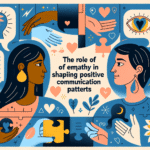
Isolation and Invisibility: The Profound Psychological Impact of Chronic Illness on Social Life
Introduction
Chronic illness can be a silent thief. It creeps into daily life, gradually stealing away not just physical health but also social connections, joy, and a sense of belonging. The profound psychological impact of living with chronic illness often manifests as isolation and invisibility, leaving individuals feeling disconnected from friends, family, and the world around them. In our rapidly evolving society, the importance of understanding this phenomenon cannot be overstated. As more individuals grapple with chronic conditions, recognizing their struggles is essential for fostering empathy and support.
This article delves into the intricate layers of isolation and invisibility faced by those living with chronic illnesses, examining how these challenges affect their social lives. By utilizing unique case studies, relevant data, and actionable insights, we aim to offer a comprehensive exploration of this critical issue.
Understanding Chronic Illness: A Double-Edged Sword
Chronic illnesses, such as fibromyalgia, lupus, rheumatoid arthritis, and many others, are defined by their long-lasting nature and the way they can dramatically influence daily living. The consequences of such ailments extend beyond physical limitations, leading to:
- Emotional distress
- Social withdrawal
- Changes in identity
Table 1: Common Chronic Illnesses and Their Psychological Impacts
| Chronic Illness | Common Symptoms | Psychological Impact |
|---|---|---|
| Fibromyalgia | Pain, fatigue | Depression, anxiety |
| Rheumatoid Arthritis | Joint pain, stiffness | Isolation, irritability |
| Multiple Sclerosis | Fatigue, mobility issues | Invisibility, social avoidance |
| Lupus | Fatigue, joint pain | Low self-esteem, relationship strain |
Case Study 1: The Experience of Sarah with Fibromyalgia
Sarah, a 34-year-old mother of two, was diagnosed with fibromyalgia five years ago. Initially, Sarah faced physical symptoms like debilitating fatigue and chronic pain, but as the disease progressed, she noted a creeping sense of isolation. Friends stopped inviting her out, assuming she wouldn’t be able to attend, and family members struggled to understand her invisible illness.
Analysis: Sarah’s experience highlights a common path for individuals with chronic illness: the transition from an active social life to a feeling of invisibility within social circles. This can lead to feelings of loneliness, further exacerbating psychological distress.
The Cycle of Isolation
Emotional Withdrawal
Individuals suffering from chronic illnesses often experience overwhelming emotions, battling constant pain and fatigue. Over time, this can lead to a cycle of emotional withdrawal, wherein they pull away from social activities that once brought joy. As isolation deepens, the gap grows tougher to bridge, leading to increased feelings of invisibility.
The Role of Guilt and Shame
Many who live with chronic illnesses grapple with guilt. They may feel they are burdening their friends and family by not participating in social activities. This sense of guilt can inhibit social interaction further, adding another layer to their isolation.
Case Study 2: Mark’s Struggle with Rheumatoid Arthritis
Mark, a 40-year-old graphic designer, developed rheumatoid arthritis in his late thirties. While he once thrived in collaborative environments, the disease forced him to work from home. In meetings, Mark felt invisible—often muted by his discomfort and struggle to engage actively.
Analysis: Mark’s case exemplifies how chronic illnesses can shift not only personal social dynamics but also professional interactions. He felt left out and invisible, which compounded his emotional struggles.
The Social Impact of Invisibility
Relationships Transform
Chronic illness reshapes relationships. Friends may drift away due to misunderstanding or a perceived lack of availability. Family members may become caregivers, altering the dynamics of the relationship from companionship to caretaker-ship.
Case Study 3: Lisa’s Changed Relationships
After her lupus diagnosis, Lisa found that her best friend gradually distanced herself, claiming she didn’t know how to handle Lisa’s needs. While Lisa craved understanding and support, she instead felt isolated and invisible, struggling to communicate her needs.
Analysis: Lisa’s situation depicts the significant social fallout that can occur when chronic illnesses strain personal relationships. The transition from typical friendship behavior to apprehension can leave individuals feeling abandoned.
Understanding Invisibility in Society
The Cultural Perception of Chronic Illness
In many societies, chronic illnesses remain largely misunderstood and overlooked, leading to a lack of awareness. This can reinforce the feelings of invisibility for those affected, creating a culture where their struggles go unnoticed. The societal narrative often prioritizes visibility; disabling conditions, by their very nature, challenge that narrative.
Table 2: Cultural Perceptions of Chronic Illness
| Societal Attitude | Effect on Individuals |
|---|---|
| Lack of Awareness | Increased isolation |
| Stigmatization | Feelings of invisibility |
| Emphasis on Visibility | Pressure to conform to societal norms |
Case Study 4: Jonathan’s Public Struggle
Jonathan, 28, battles with Crohn’s disease, which often causes flare-ups and unpredictable symptoms. He attended a health fair hoping to connect with others, but felt invisible as people passed by, looking for “healthier” narratives. This public encounter only deepened his isolation.
Analysis: Jonathan’s experience illustrates societal perceptions of health. The focus on visible health can exacerbate the feelings of invisibility for those living with chronic conditions.
Navigating the Path Towards Connection
Building a Support Network
For those facing chronic illnesses, establishing a robust support network can dramatically ease feelings of isolation. Support groups, whether in-person or online, can pave the way for understanding and empathy, making individuals feel less invisible.
Open Communication
Encouraging open dialogue within relationships can help mitigate feelings of isolation. Friends and family must understand the complexities surrounding chronic illnesses to foster supportive environments.
Case Study 5: Emma’s Journey to Connection
Emma, a 52-year-old with chronic fatigue syndrome, recognized the importance of open communication. She organized a small gathering, inviting a few close friends to help them understand her experience better. The event led to increased awareness and a renewed willingness from her friends to include her.
Analysis: Emma’s proactive approach in fostering understanding among friends illustrates the potential for enhancing relationships when individuals openly communicate their struggles.
Conclusion: Empowerment through Awareness
The exploration of isolation and invisibility: the psychological impact of chronic illness on social life reveals a deep and often unseen struggle faced by many. It is crucial for society to foster environments where individuals with chronic illnesses feel seen, heard, and understood. By developing awareness, open communication, and robust support systems, those affected can reclaim their social lives, breaking the cycles of isolation.
Educating ourselves and others about the realities of chronic illness can bridge the gap between awareness and empathy, allowing individuals to move from invisibility to visibility. In this journey, support and connection can replace isolation, leading to a more inclusive society.
FAQs
1. How do chronic illnesses lead to social isolation?
Chronic illnesses can lead to social isolation due to physical limitations, emotional distress, and changes in relationships, resulting in a reduced engagement in social activities.
2. Why do people with chronic illnesses sometimes feel invisible?
They can feel invisible due to a lack of understanding from family and friends, stigmatization of their condition, and societal attitudes that prioritize visible health over unseen struggles.
3. How can friends and family support someone with a chronic illness?
Support can be offered through open communication, understanding their experiences, including them in social activities, and being patient and non-judgmental about their needs.
4. What role do support groups play in combatting isolation?
Support groups provide a safe space for sharing experiences, fostering understanding, and creating connections with others who share similar challenges, thereby alleviating feelings of isolation.
5. Can awareness campaigns help reduce feelings of invisibility?
Yes, awareness campaigns can help educate the public about chronic illnesses, reduce stigma, and promote empathy and inclusivity, thereby helping individuals feel more visible and supported.
By addressing the nuances of isolation and invisibility: the psychological impact of chronic illness on social life, we can foster a society where everyone feels valued and understood, transforming lives one connection at a time.

















